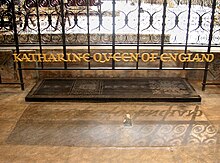After dropping my family at the airport for their Camino Portuguese we visited Peterborough Cathedral where we found a link to the Camino de Santiago.
The Cathedral is dedicated to Saint Peter, Saint Paul and Saint Andrew and was founded in the Anglo-Saxon period. Its architecture though is mainly Norman as it was re-built in the 12th century
Catherine
was born in 1485 to Isabella I of Castile and Ferdinand II of Aragon and at
three years of age was betrothed to Arthur the Prince of Wales and heir
Apparent to England throne. The two were married in 1501 and on the way to her
wedding in 1499 she visited Santiago Cathedral. There are stories that say that
during the service she attended the Botafumero came off its rope, flew through
one of the Cathedral’s windows and landed outside. Although no-one was hurt it
was later said that this should have been taken as an ill omen.
Five
months after their marriage Arthur died but Catherine stayed at Court becoming the
Spanish Ambassador to England in 1507 (making her the first female ambassador
in European history).
When Henry
became King the two married in 1509 and Catherine even served as Regent in
England for six months in 1513 while Henry VIII was in France.
By 1525
Henry was infatuated with Anne Boleyn (and dissatisfied that he and Catherine
had no sons) and so tried to have their marriage annulled but Pope Clement VII
refused this. Hence Henry assumed supremacy over religious events meaning that
in 1533 his marriage to Catherine was declared invalid although Catherine
refused to accept Henry as the head of the Church and always considered herself
to be Henry’s rightful wife. Henry though saw her only as the Dowager Princess
of Wales and banished her from Court so that she lived at Kimbolton Castle
dying there in 1536. She was then buried at Peterborough Cathedral.
Catherine's Grave in Peterborough Cathedral (taken from https://en.wikipedia.org/wiki/Catherine_of_Aragon)
Several Saints have been interred in Peterborough Cathedral's alter: Wilfred, Tatberht, Sicgrid, Botwine, Albert, Wulfgar and Wildegel and there would probably have been Pilgrims to this site although we saw nothing about this whilst we were there.
If you want to visit the Cathedral it operates on a donation basis.



Comments
Post a Comment